Description: War Thunder is a next generation military MMO game dedicated to...

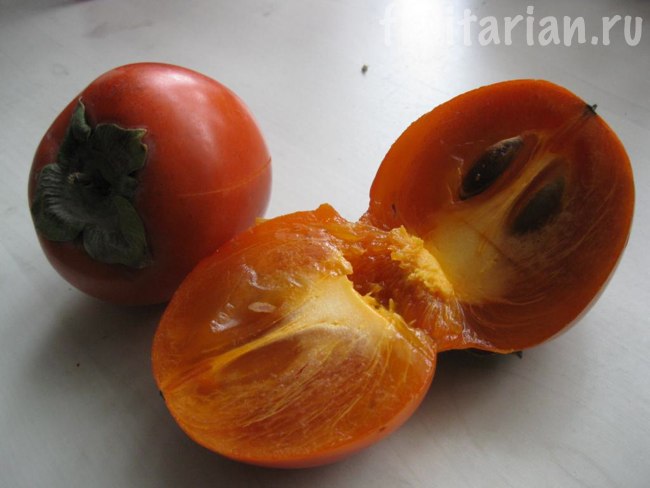
— Persimmon Korolek Chocolate
The most delicious persimmon. Persimmon The kinglet is round in shape, with an orange skin, through which chocolate pulp often peeps. The browner the flesh of this persimmon, the tastier and sweeter it is. This persimmon has a lot of elongated seeds, from 4 to 12-14 pieces. This persimmon simply has a divine taste, unique. It is very sweet, yet juicy and not cloying. Kinglet is never viscous, even when immature. By the way, this persimmon is edible in solid form, but in this case it is not so sweet at all.
In terms of sweetness, persimmon Korolek can be compared with and - they are all very sweet and insanely tasty, but not cloying, after eating them there is never a feeling of an overabundance of sweets.
— Large persimmon type Korolka
This variety of persimmon is similar to the above mentioned Wren, but the difference is that the fruits of this persimmon are much larger, the flesh is less brown, and when this persimmon is unripe, it knits a little, but when fully ripe, there is no trace of viscosity. If Korolka tastes more chocolatey and the color is mostly brown with yellow tints, then this persimmon is red-brown with nutty notes in taste. Divinely delicious! 
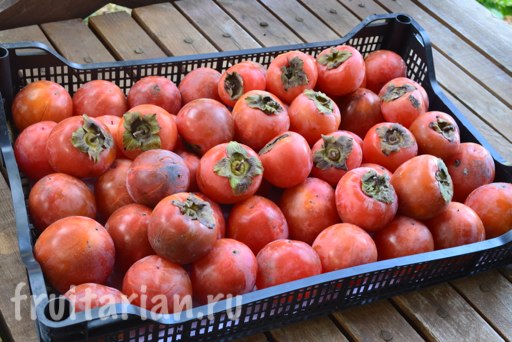
— Early Honey King
Until the chocolate King has ripened, we are pleased with such a non-chocolate one. It is also very sweet and tasty, but light on the inside and without those signature notes that are specific to chocolate Korolok. Delicate ‘snotty’ persimmon, delicious. Early. 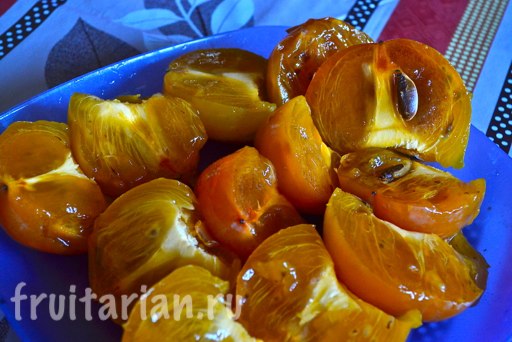
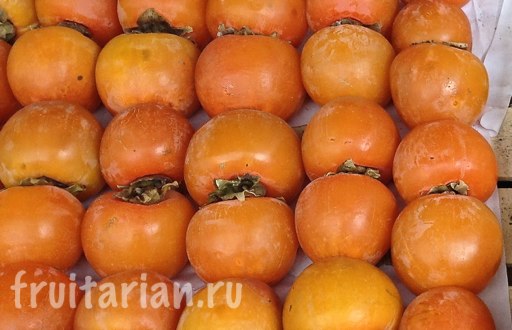
— Persimmon honey / tangerine
No wonder this persimmon was given such names. It is tangerine because its shape repeats the shape of a tangerine, and honey - to taste. This is one of the sweetest varieties of persimmon, it is often even cloying. Eat a few pieces and then it is impossible to eat because of its strong sweetness. In this persimmon there are never seeds, and the pulp is always bright orange in color, when the fruit is fully ripe, it becomes a jelly-like consistency, liquid. This persimmon is very delicate, and when it is ripe, it is not transported at all, it is even impossible to carry it in a bag.
More about this persimmon. 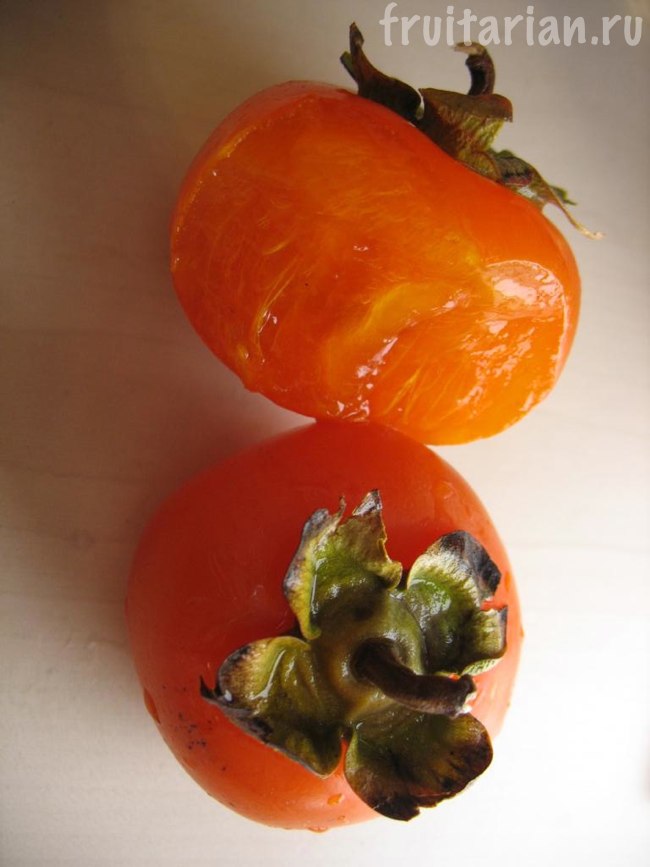
— persimmon tomato/ Bull's heart
A very tasty persimmon variety, very large and seedless. It really resembles in shape and size a huge Bull's heart. The flesh of this persimmon is always orange in color, does not darken when ripe, but it becomes very soft and tender. Ripe tomato persimmon is also difficult to transport as the above honey. A very sweet variety of persimmon, but not as cloying as Honey. This variety is also sometimes called Bull's Heart. 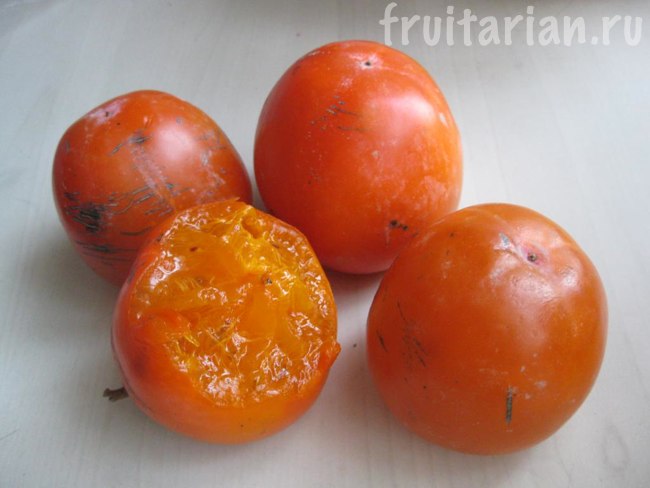
— Persimmon Sharon
This is a super mega sweet persimmon. It is edible both hard and very soft. When the Sharon persimmon is fully ripe, it is even more tender and soft than the previous persimmon and than the honey/tangerine. In a ripe state, it can be carried from the store to the house only in a box (in a bag it will turn into snot). Early, Azerbaijani persimmon first appears on the fruit counters.
The Azerbaijani Sharon persimmon has sharp tips (photo below), and the Spanish Sharon has a smooth shape with pressed crosses at the end. 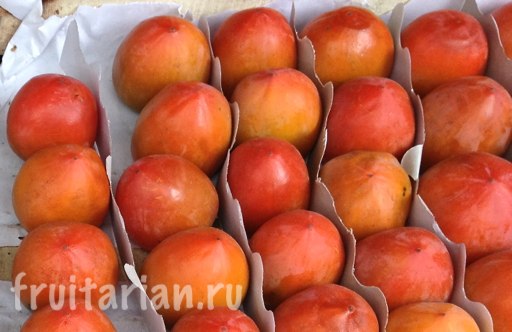
Incredibly tasty little persimmon with the consistency of marmalade and the taste of sherbet (nutty), chocolate bars like Snickers and candies with nuts. Provided, of course, that this persimmon hung on the tree for enough time and gained the desired sweetness and taste. Read more about this chic variety. 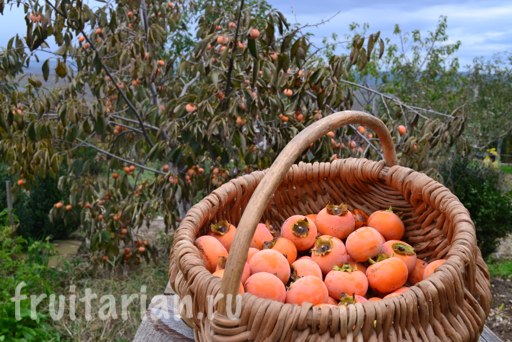
— Persimmon Fig chocolate / Chamomile / Fuyu pollinated
The earliest of all varieties of persimmon, it is she who appears on the sale of the very first. The Azerbaijani one is mega-sweet and super-tasty, while the Chinese one is bland.
When it is pollinated, then its flesh is chocolate, as well as the taste too, plus there are seeds: 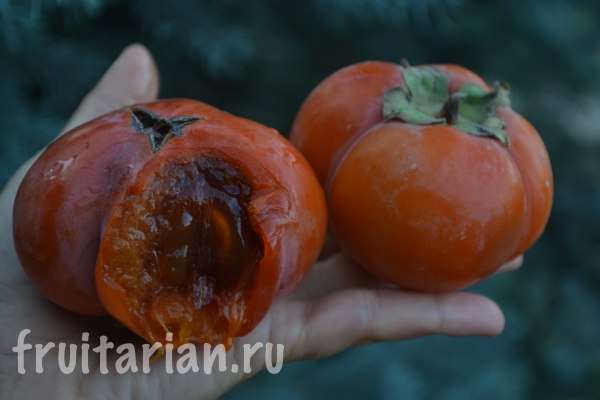
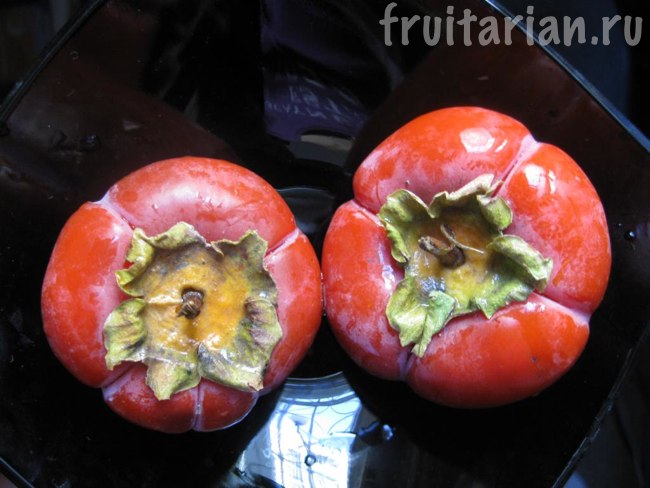
And this is persimmon Fig Honey (Fuyu non-pollinated). Those. she, only unpollinated, so she is pitted, she has yellow flesh, and the taste is not chocolate, but more honey. 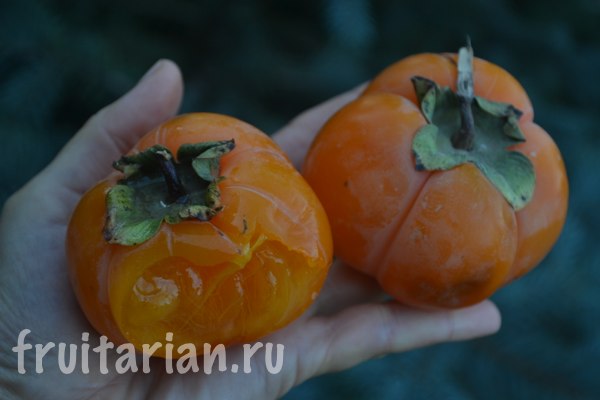
— common persimmon
This is the worst kind of persimmon. She knits even in a ripe state. Its skin and flesh are always orange. 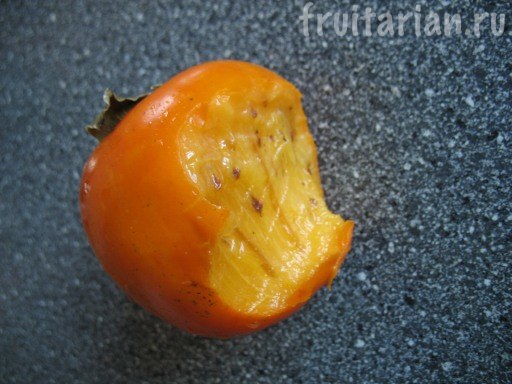
— Chinese persimmon
Almost all varieties of Chinese persimmon have a very specific shape - with a stripe. Even when this persimmon is very ripe and soft, it still lacks sweetness. And also it has a hard peel, which Uzbek persimmon never has. I have never come across a good Chinese persimmon. 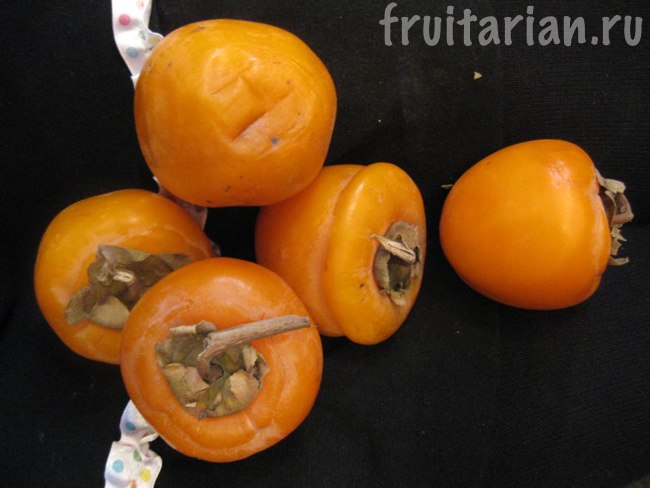
— Pulled Egyptian persimmon
Beautiful, but the taste is not the same as that of Chinese persimmon. 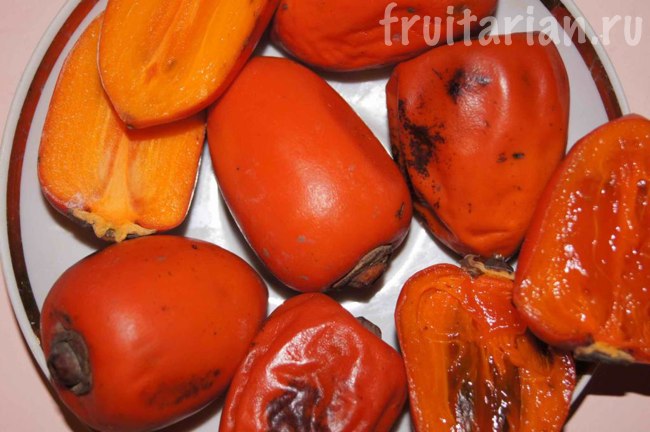
I have been wanting mud treatment for a long time. I have nothing to treat, but it certainly won’t be superfluous. It must be a very cool process!
Among the huge number of tropical fruits, persimmon is far from the last. This tart, incredibly sweet and fragrant fruit is a favorite of all gourmets. It is included in many gourmet dishes, although it can be eaten without additives and seasonings, this will not make the taste worse. There are different varieties of persimmon, which differ from each other in taste, origin and other parameters. Consider which of them are the most popular, the sweetest.
Some varieties of persimmons get their names because of their appearance or taste. Among those there is also a variety of kinglet, or chocolate persimmon. It is believed that the fruits of such a tree are the most delicious, the sweetest. It grows mainly in subtropical and tropical regions, bears fruit several times a year. A dark brown flesh shows through the dark orange skin of a ripe persimmon. It has a very sweet taste, which at the same time does not have cloying. They say that such juicy varieties of persimmons are created in order to get drunk with them. These fruits contain the maximum amount of water. 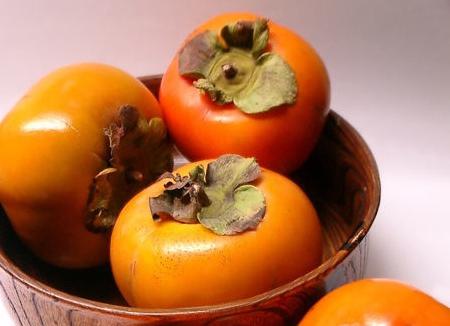
This variety is followed by tangerine, or, as it is also called, Such fruits are small in size, their skin has. When the fruit is fully ripe, it becomes very soft, to the point that it spreads in the hands. Honey persimmon has such a name because it has an incredibly sweet taste, up to cloying.
An analogue of tangerine persimmon is tomato, which is sometimes called a bull's heart. Its fruits are large and juicy, after full ripening they retain their bright orange color. The pulp becomes soft, sweet and literally spreads in the hands. That is why these fruits are not transported, but eaten directly in the places where they grow.
Now let's talk about hard varieties of persimmon, among which there is Egyptian, elongated. Such fruits are considered one of the most beautiful, they are often used for serving luxurious tables. However, lovers of sweet fruits dislike the Egyptian variety because of its hardness and astringency. Elongated persimmons are often cut into salads, baked with meat. 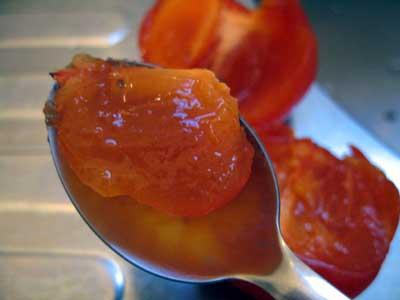
Hard, tart and Chinese persimmon, which also has a specific shape. Unfortunately, in our regions, such fruits are not so common. In the original, these are fruits of a light orange color, inside of which there is a hard pulp. Also, the “Chinese woman” has notes of astringency in its taste, like all hard varieties of persimmon. Photos of these oriental berries clearly demonstrate the originality of their shape.
Among the hard varieties, it is also worth mentioning the "Russian", which grows both in the tropics and in the southern part temperate latitudes. Berries have a tart taste with hints of sweetness, the flesh is soft if the fruit is fully ripe. The Russian persimmon variety is late, the berries are ripe by November, and after that they can be transported to any corner of the planet. This variety is considered one of the most common, since the tree itself is unpretentious, and the fruits are tasty and beautiful.
Varieties of persimmon with a photo: the most delicious and sweet, for growing in the Russian FederationPersimmon (lat. Diōspyros) has been known to man for over 2000 years. For its unique taste with many different shades, it is also called the "Plum of the Gods". Due to the rather low calorie content (from 60 to 120 calories depending on the variety) and the high content of vitamins and microelements, this product is indispensable in the diet of every person, especially in winter period.
We are accustomed to using persimmon fruits only fresh, enjoying the juicy and slightly tart pulp. But this fruit is also widely used to make compote, delicious marmalade, jam, marmalade and even wine. Wonderful dried fruits are made from it, and a special kind of coffee is obtained from the grains of the seeds. The wood of this tree is highly valued and is called "black". It is used for the manufacture of furniture, parquet and sports equipment.
Tropics and subtropics are considered homeland. This plant is a huge sprawling tree up to 30 m high, but there are also dwarf varieties for growing at home. At the beginning of summer, it is covered with many fragrant flowers of red, yellow or white, and by the end of autumn amazing sunny fruits ripen on it. Their size and color may vary depending on the variety.
Currently, there are more than 300 varieties of this plant. The taste of fruits is different - from tart to sugary sweet. When ripe, the flesh becomes like a jelly that can be eaten with a spoon, while some varieties remain firm even at the end of the ripening period.
Many people know that persimmon "knits the mouth", but not everyone knows why this happens and how to choose the right fruits. It’s worth mentioning right away that not all varieties have such a property, mainly Eastern varieties and frost-resistant varieties (grown on the territory of the Russian Federation). Such as Shokoladnitsa and Sharon, do not have astringency even in an unripe form, only if they are consumed completely green (seen by color).
The sensation of viscosity in the mouth appears due to the tart taste of unripe fruits. Some varieties are visually almost impossible to distinguish, since they are orange in color even in an unripe form.
When buying an Eastern or local persimmon, you should pay attention to the softness of the fruit: the peel should not look like a film, but it should be easy to squeeze through with a little pressure with your finger. The color of the persimmon, if it is not a Chocolate Girl variety, may be dark orange, but not brown. The darkened fruits will not “knit your mouth”, but their taste will also be similar to porridge.
If you bought a tart, unripe persimmon, this is not a problem. Put it in the fridge or even better in the freezer. After 3-4 hours, the astringency will disappear, and the pulp will become very sweet and will not turn into jelly (due to this quality, many people prefer to buy unripe persimmons and freeze them).
Weather greatly affect the taste and quality of fruits. Transportation is also an important factor: if the persimmon fully ripens on the tree, then it will be much tastier than the one that ripened during transportation or storage.
Among the many varieties of this fruit, the most delicious and affordable varieties in the regions of Russia are distinguished. Korolkovy persimmon, which is deservedly considered the sweetest, is especially popular. It should be noted that what more seeds in fruits - the tastier they are. The most popular varieties of this group include Hyakume, Zenji-Maru, Gately.
The persimmon of the Hyakume variety is the most common of the Korolkov family, it produces large, elongated fruits weighing up to 250 grams, for which it received the name Korolek. Their color can vary from honey yellow to dark brown. It is thanks to the color and unique taste that the variety is often called "Chocolate", but you should not confuse it with Zenji-Maru (popularly Chocolate).
Fruits differ in good transportability. Their skin is smooth and dense, which allows the fruit to maintain its presentation for a long time. The pulp has a sweet, delicate taste. Even unripe fruits have a honey aroma and are completely intolerant. young tree begins to bear fruit already 4-5 years after planting, and the yield can reach 200 kg per unit. However, this species is not resistant to severe frosts and requires good shelter at temperatures below -18ºС.
According to the characteristics and appearance practically indistinguishable from Hyakume. It has a slightly darker flesh, and a more sugary aftertaste. It is generally accepted that the more seeds in the fruit, the higher its taste. Trees of this variety also bring an excellent harvest, but are thermophilic, they are recommended to be grown in areas where the temperature does not fall below 15.
Persimmon varieties "apple" are in high demand. They got their name due to the crossing of this fruit with an apple tree. Among the most popular subspecies, Sharon can be distinguished, which has an amazing delicate aroma reminiscent of quince and apricot.
Large juicy fruits have no seeds and astringent taste. Even when ripe, the flesh remains firm, like an apple, and has a bright orange color. Sharon is unpretentious in cultivation and is well transported, but it is not adapted to the northern climate.
Varieties of Eastern or Japanese persimmon are considered the largest:
Varieties of persimmons can be conditionally classified according to the ripening time:
For gardeners in Russia, persimmon varieties of early ripening and high frost resistance are most interesting. Since there is nothing nicer than having these exotic fruits grown in own garden.
The following persimmon varieties are most suitable for growing in Russia:
Persimmon Virgin (or American) is a huge tree up to 25 meters in height, rather undemanding to soil and humidity. The plant is able to withstand frosts and -35ºС without shelter for the winter. Due to its high frost resistance, it is the only variety suitable for middle lane Russia.
It is preferable to plant in open areas, as this subspecies requires a lot of light. Persimmon variety Virginskaya has small fruits, their diameter is 2-6 cm, and the pulp is sweet and nutritious.
This variety was bred by breeders of the Nikitsky Botanical Garden in Crimea and has the following characteristics:
This is one of the best hybrids, the fruit weight of which reaches 270 grams. The pulp of the fruit has a burgundy color and has excellent palatability. Their ripening period begins at the end of October. Persimmon varieties Mount Goverla is quite frost-resistant and can withstand up to -24ºС.
The Mountain Roman-Kosh tree has good frost resistance down to -25 degrees. But in order to get a generous harvest, pollination is necessary. The fruits are yellow in color and begin to ripen in early November. They are stored for a long time and can lie until January.
If you decide to grow persimmons in your own garden, then when choosing a variety, you must give preference to frost-resistant ones. By observing the correct and timely care, as well as providing high-quality shelter for the winter, after 3-4 years you will be able to enjoy excellent and very useful fruits, as well as the view of a beautiful tree that will decorate any site.
To get the most out of eating persimmons, you need to choose the right variety.
Heart apple tree, winter cherry, gourmet choice, Chinese peach, divine plum - it's all about her, about persimmon. It appears on store shelves and markets in October and remains a very useful delicacy until the end of winter, which helps to cope with winter beriberi.
To get the most out of eating persimmons, you need to choose the right variety. And also be able to cook the right dish from it. After all, this fruit can be consumed not only raw, but also in many other forms.
Beneficial features
Persimmon is a storehouse of vitamins A and C, natural sugars - fructose and glucose, fruit acids - malic and citric. It contains quite a lot of manganese, potassium, copper and iron.
So this fruit powerful weapon against winter beriberi. It quickly satisfies hunger and at the same time is low in calories (62 calories per 100 g), strengthens the immune system, helps overcome depression and insomnia, “fixes” the intestines in case of digestive disorders, and normalizes blood pressure.
Doctors say that daily eating 100 g of persimmon (1 medium-sized or 2 small fruits) will help to avoid atherosclerosis. CAUTION: DO NO HARM! But there is also flip side medals. Due to the abundance of sugars, persimmon is contraindicated for diabetics and those suffering from obesity.
Persimmon is contraindicated for children under 3 years of age. The fact is that persimmon contains special substances - tannins, which, interacting with gastric juice, form a viscous mixture.
As a result, in the child's stomach, pieces of persimmon are combined into one lump, which greatly complicates the process of digestion and can cause unwanted reactions.
Where does the astringent taste of persimmons come from?
This berry has an astringent taste. It's all about the tannins. But, as soon as the persimmon ripens, these substances disappear and the berry becomes sweet.
Conclusion: it is necessary to eat only ripe fruits, especially since there are unripe fruits - it is dangerous for health. But what if you bought a persimmon, and she knits?
Do not rush to send it to the bin - under the right storage conditions, the fruit may ripen.
Varieties
Persimmon has about 500 varieties. The love and respect of Russians earned about a dozen of them.
chocolate kinglet
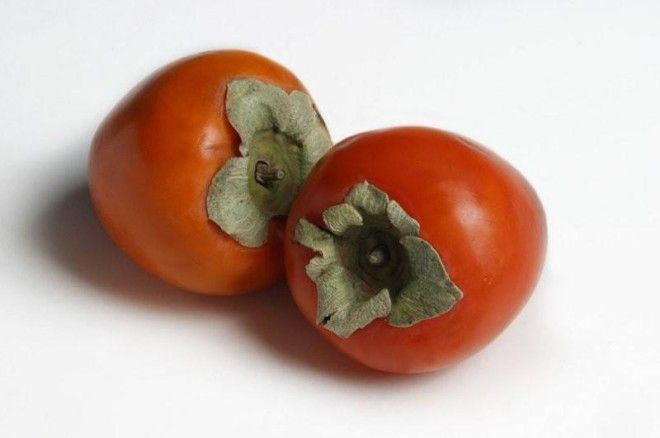
And what is characteristic, even the unripe fruit does not have a hint of astringent taste. It remains sweet under any circumstances.
Tangerine persimmon (or honey)
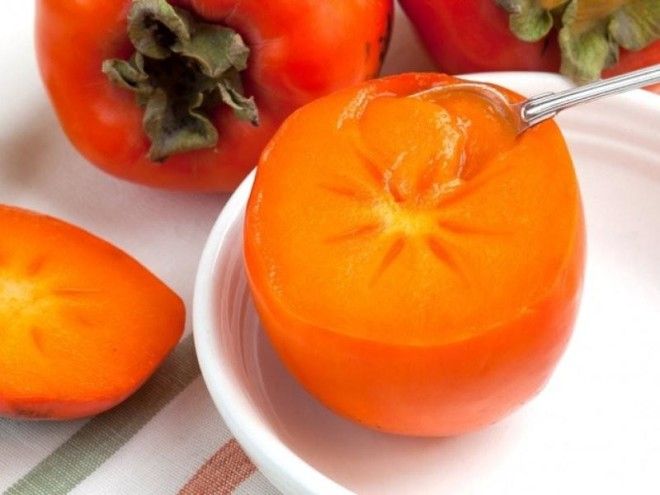
Chinese persimmon
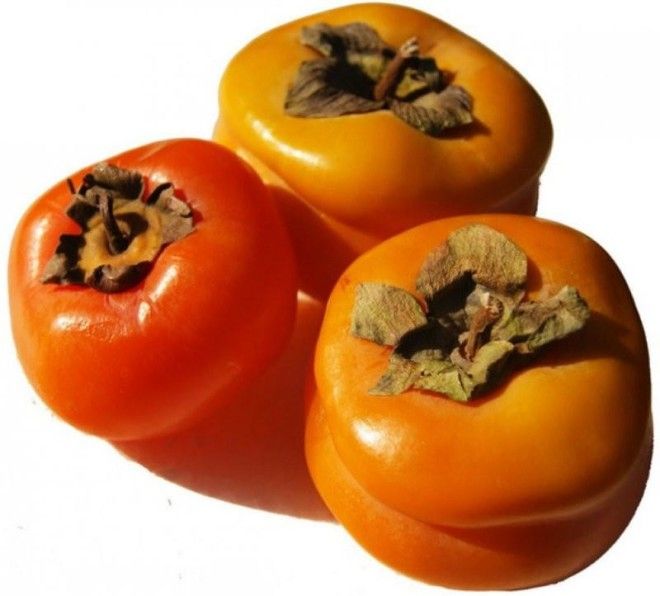
The taste is very specific: astringency is present regardless of the degree of ripeness of the fruit, so the Chinese persimmon is necessarily tart and astringent in taste, it lacks sweetness.
But if you hold it for a short time in the freezer, the viscosity and astringency will go away. True, it still does not become sweeter.
Sharon
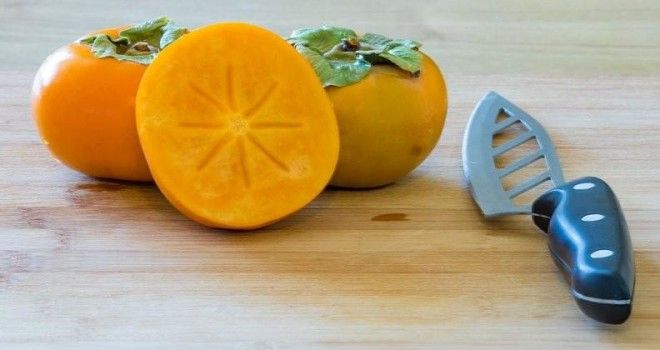
A hybrid was bred in Israel in the Saron Valley, from where it got its name. There are no seeds or seeds in the fruits. Both ripe and unripe fruits are sweet.
In addition to the Israelis, Azerbaijan and Spain are engaged in breeding Sharon. Azerbaijani fruits are pointed at the end, Spanish ones have grooves in the form of a small cross in the same place.
Russian woman
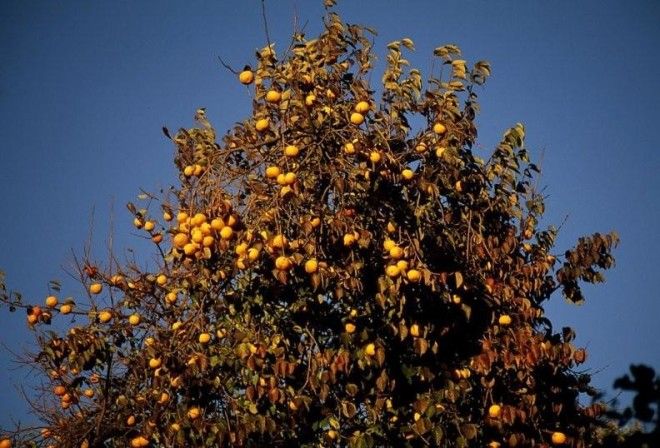
Chamomile (fig persimmon)
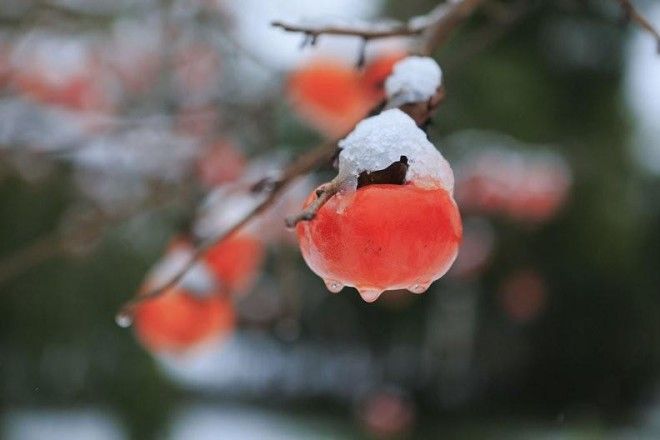
Seedless fruits are viscous in taste, with stones they are tastier, the taste largely depends on the climate of the producing country: the further south, the sweeter. So feel free to ask where the persimmon comes from. HOW TO CHOOSE? Choose round, bright, rich-colored fruits. The peel should be smooth and shiny, without damage. If it has dark spots and stripes, the persimmon has begun to deteriorate.
Ripe persimmons have dry and dark stalk and leaves. Feel the fruit. Soft - means ripe, will not knit. You can eat. Fruits that are firm to the touch most often require ripening.
How to store?
Unripe persimmons can be put in the freezer for a while. Thawed fruits become tastier and sweeter.
Unripe fruits can also be kept in warm water for 10-12 hours to ripen. Persimmons and apples with tomatoes also help to reach the desired condition.
Put them in one bag with persimmons: ethylene, which is released by the listed vegetables and fruits, accelerates ripening. By the way, persimmons can be canned and dried. After drying, persimmon becomes a real oriental sweet.
Choose hard, pitted fruits, peel, cut into pieces - and into the oven, temperature 40-45 ° C. Make sure that the fruits do not darken.
persimmon dishes
You can use persimmon as an independent product, and add it to salads, prepare drinks, desserts from it, cook jam, jelly.
Cut into saladshurma along with tomatoes, onions, walnuts and sprinkle with fresh ginger root and basil herbs.
Persimmon chutney seasoning (for poultry)
Fry 1 onion in oil, add the pulp of 7 persimmon fruits, 1 sprig of thyme, 1 Bay leaf, 1 tsp wine vinegar, 1 tbsp. l. honey. Mix and simmer for 15 minutes, then add 25 g of roasted pine nuts.
Mascarpone and persimmon mousse
Peel 4 ripe persimmons and grind them into a puree. Mix 100 g mascarpone, 125 ml whipped cream and 4 tbsp. l. sugar, add egg whites with a little sugar and vanilla. Mix gently and refrigerate. Serve in glasses.
Indian chutney sauce
Mix persimmon puree and yogurt in a ratio of 1:2, sprinkle with sesame seeds, garnish with a mint leaf.
The main varieties presented in the Crimean markets: kinglet, sharon, virginia.
The benefits of persimmon
Persimmon contains many vitamins of groups B, A, C and P, iron, iodine, manganese, potassium and copper, ?-carotene, so it is recommended for dietary and baby food. The astringent taste of persimmon is due to great content pectin and tannin. Persimmon is contraindicated for patients diabetes and obese, because it has a high glucose content.
Doctors recommend using persimmons for those whose lifestyle is associated with tension and stress: it increases appetite, performance, relieves fatigue and improves mood. This berry is also shown for the prevention of atherosclerosis, maintaining the cardiovascular system in good shape. Due to the high content of iodine, it is useful for patients suffering from diseases. thyroid gland. The large amount of antioxidants found in delicious fruit, successfully fight free radicals, which is excellent prevention oncological diseases.
Due to the high content of tannin, persimmon should not be consumed in the postoperative period (organs abdominal cavity), as well as people who have developed adhesive bowel disease due to abdominal surgery. The use of persimmons, especially unripe fruits, in which the highest content of tannin, can lead to acute intestinal obstruction and urgent surgery.
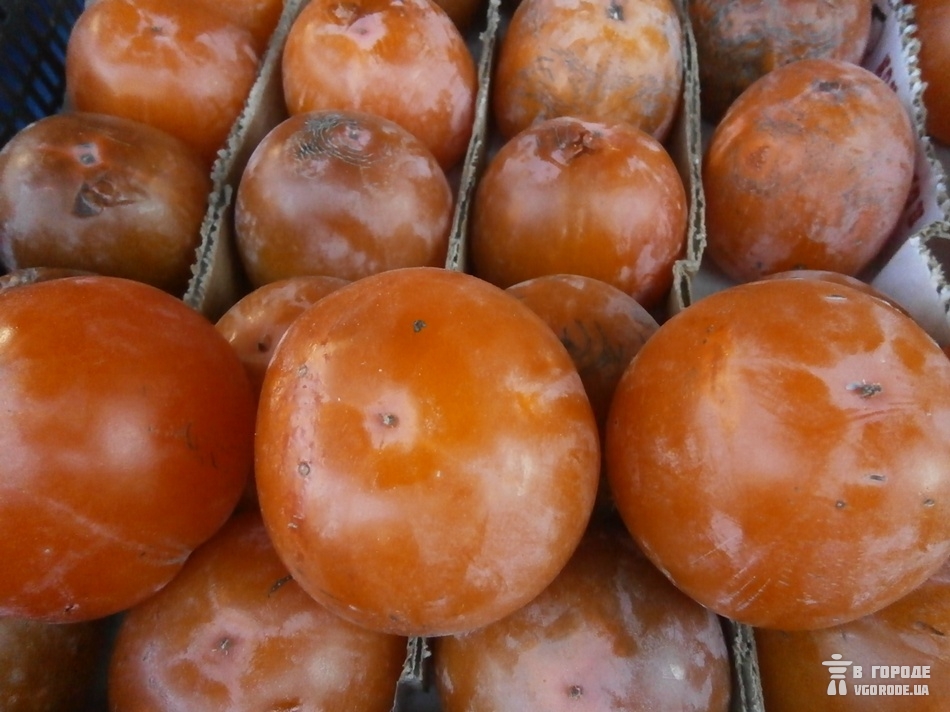
You can eat like this, or you can cook sweets.
persimmon dishes
Persimmon is not just a tasty and healthy fruit, an independent product that is good raw. A lot of salads, drinks, desserts and pastries are prepared from this cheerful berry. Persimmon is used to make jam, jams, soufflé, jelly, it is cured, dried and canned.
Egyptian persimmon salad is prepared with tomatoes and onions, dressed with walnuts, sprinkled with fresh ginger root and basil greens, sprinkled with lemon juice. All ingredients are cut extremely thinly and carefully mixed, put in a salad bowl with a slide, sprinkled with ground nuts.
Persimmon pies are a real mystery for guests. Pass fresh persimmon through a meat grinder, add quite a bit of flour and water to make a thick filling. Sweet yeast dough is rolled into cakes, put the filling and fried in butter on both sides in a hot frying pan.
With persimmon, you can cook meat and chicken. To do this, overripe fruits are mashed, mixed with finely chopped onions. This mixture is smeared with a poultry carcass or a piece of pork, grated with salt and pepper, and baked in the oven until tender. This puree gives ready meal unusual ruddy color and a touch of sophistication and piquancy.
How to choose a ripe persimmon?
Often, persimmons go on sale unripe, because they are tart and astringent. Ripe persimmons are bright orange to dark brown (depending on variety) with brownish leaves. In this case, the fruit should be translucent.
The skin should be thin, smooth, easy to press, but firm. Leaves and stalk should be dry, brown. The pulp of a ripe fruit is semi-liquid, jelly-like or mealy-pasty.